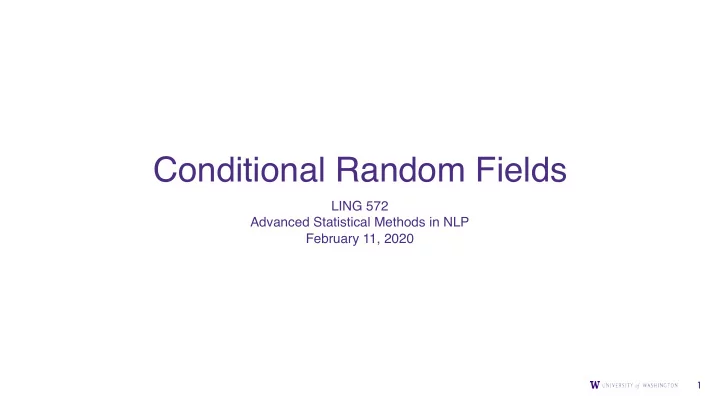

Conditional Random Fields LING 572 Advanced Statistical Methods in NLP February 11, 2020 1
Announcements ● HW4 grades out: 93.1 mean ● HW6 posted later today ● Implement beam search ● Note: pay attention to data format + feature vectors (in test time situation) ● Reading #2 posted! ● Due Feb 18 at 11AM 2
Highlights ● CRF is a form of undirected graphical model ● Proposed by Lafferty, McCallum and Pereira in 2001 ● Used in many NLP tasks: e.g., Named-entity detection ● Often conjoined with neural models, e.g. LSTM + CRF ● Types: ● Linear-chain CRF ● Skip-chain CRF ● General CRF 3
Outline ● Graphical models ● Linear-chain CRF ● Skip-chain CRF 4
Graphical models 5
Graphical model ● A graphical model is a probabilistic model for which a graph denotes the conditional independence structure between random variables: ● Nodes: random variables ● Edges: dependency relation between random variables ● Types of graphical models: ● Bayesian network: directed acyclic graph (DAG) ● Markov random fields: undirected graph 6
Bayesian network 7
Bayesian network ● Graph: directed acyclic graph (DAG) ● Nodes: random variables ● Edges: conditional dependencies ● Each node X is associated with a probability function P ( X | parents ( X )) ● Learning and inference: efficient algorithms exist. 8
An example (from http://en.wikipedia.org/wiki/Bayesian_network) P(rain) P(sprinkler | rain) P(grassWet | sprinkler, rain) 9
Another example P(E) B E P(B) P(A|B, E) D A P(D|E) C P(C|A) 10
Bayesian network: properties 11
E B D A C 12
Naïve Bayes Model Y … f n f 2 f 1 13
HMM … X n+1 X 2 X 3 X 1 o n o 1 o 2 ● State sequence: X 1,n+1 ● Output sequence: O 1,n n ∏ P ( X i +1 | X i ) P ( O i | X i +1 ) P ( O 1: n , X 1: n +1 ) = π ( X 1 ) i =1 14
Generative model ● A directed graphical model in which the output (i.e., what to predict) topologically precedes the input (i.e., what is given as observation). ● Naïve Bayes and HMM are generative models. 15
Markov Random Field 16
Markov random field ● Also called “Markov network” ● A graphical model in which a set of random variables have a Markov property: ● Local Markov property: A variable is conditionally independent of all other variables given its neighbors. 17
Cliques ● A clique in an undirected graph is a subset of its vertices such that every two vertices in the subset are connected by an edge. ● A maximal clique is a clique that cannot be extended by adding one more vertex. ● A maximum clique is a clique of the largest possible size in a given graph. A clique: C B maximum clique: maximal clique: D E 18
Clique factorization A B C E D 19
Conditional Random Field A CRF is a random field globally conditioned on the observation X. 20
Linear-chain CRF 21
Motivation ● Sequence labeling problem: e.g., POS tagging ● HMM: Find best sequence, but cannot use rich features ● MaxEnt: Use rich features, but may not find the best sequence ● Linear-chain CRF: HMM + MaxEnt 22
Relations between NB, MaxEnt, HMM, and CRF 23
Most Basic Linear-chain CRF 24
Linear-chain CRF (**) 25
Training and decoding λ j ● Training: estimate ● similar to the one used for MaxEnt ● Ex: L-BFGS ● Decoding: find the best sequence y ● similar to the one used for HMM ● Viterbi algorithm 26
Skip-chain CRF 27
Motivation ● Sometimes, we need to handle long-distance dependency, which is not allowed by linear-chain CRF ● An example: NE detection ● “Senator John Green … Green ran …” 28
Linear-chain CRF: Skip-chain CRF: 29
CRFs in Larger Models 30
CRFs in Larger Models 31
Source: NLP Progress 32
Summary ● Graphical models: ● Bayesian network (BN) ● Markov random field (MRF) ● CRF is a variant of MRF: ● Linear-chain CRF: HMM + MaxEnt ● Skip-chain CRF: can handle long-distance dependency ● General CRF ● Pros and cons of CRF: ● Pros: higher accuracy than HMM and MaxEnt ● Cons: training and inference can be very slow 33
Recommend
More recommend